分词做状语用法总结
- 格式:docx
- 大小:2.16 MB
- 文档页数:2
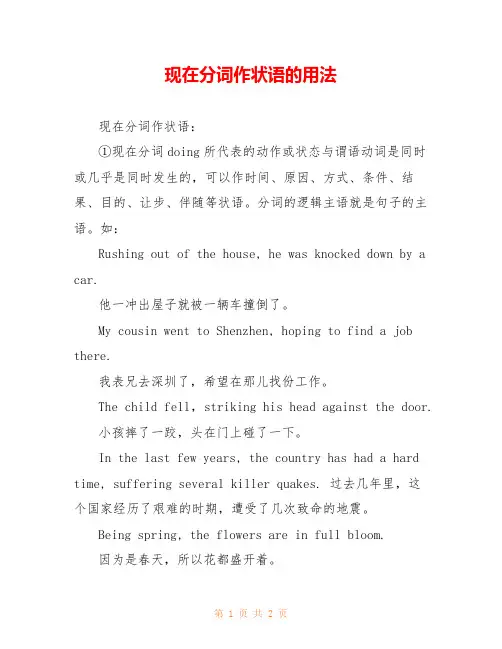
现在分词作状语的用法现在分词作状语:①现在分词doing所代表的动作或状态与谓语动词是同时或几乎是同时发生的,可以作时间、原因、方式、条件、结果、目的、让步、伴随等状语。
分词的逻辑主语就是句子的主语。
如:Rushing out of the house, he was knocked down by a car.他一冲出屋子就被一辆车撞倒了。
My cousin went to Shenzhen, hoping to find a jobthere.我表兄去深圳了,希望在那儿找份工作。
The child fell,striking his head against the door.小孩摔了一跤,头在门上碰了一下。
In the last few years, the country has had a hard time, suffering several killer quakes. 过去几年里,这个国家经历了艰难的时期,遭受了几次致命的地震。
Being spring, the flowers are in full bloom.因为是春天,所以花都盛开着。
②有些分词作状语,没有逻辑上的主语,已成为习惯用法:considering, judging from, talking of, allowingfor(考虑到),generally/frankly/honestly/roughly/strictly speaking, assuming that(假设)等。
如:Talking of this film, its wonderful.说到这部电影,好极了。
Assuming that it is true, what should we do now 假定那是真的, 我们现在该怎麽办Judging by the direction of the wind, it wont rain today.根据风向测度, 今天不会下雨。
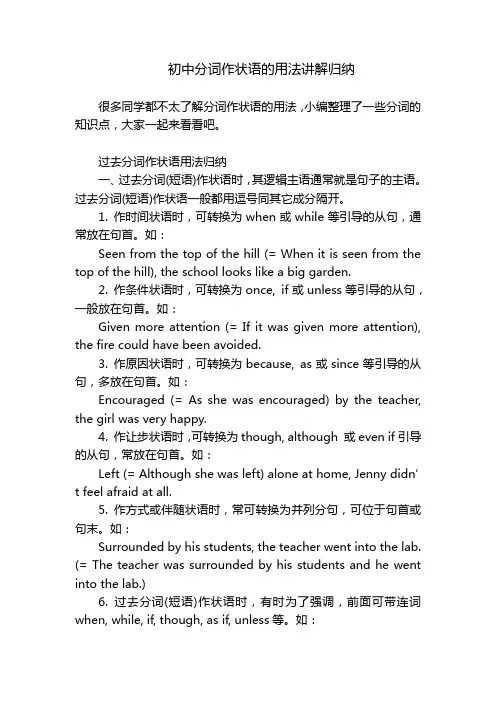
初中分词作状语的用法讲解归纳很多同学都不太了解分词作状语的用法,小编整理了一些分词的知识点,大家一起来看看吧。
过去分词作状语用法归纳一、过去分词(短语)作状语时,其逻辑主语通常就是句子的主语。
过去分词(短语)作状语一般都用逗号同其它成分隔开。
1. 作时间状语时,可转换为when或while等引导的从句,通常放在句首。
如:Seen from the top of the hill (= When it is seen from the top of the hill), the school looks like a big garden.2. 作条件状语时,可转换为once, if或unless等引导的从句,一般放在句首。
如:Given more attention (= If it was given more attention), the fire could have been avoided.3. 作原因状语时,可转换为because, as或since等引导的从句,多放在句首。
如:Encouraged (= As she was encouraged) by the teacher, the girl was very happy.4. 作让步状语时,可转换为though, although 或even if引导的从句,常放在句首。
如:Left (= Although she was left) alone at home, Jenny didn’t feel afraid at all.5. 作方式或伴随状语时,常可转换为并列分句,可位于句首或句末。
如:Surrounded by his students, the teacher went into the lab. (= The teacher was surrounded by his students and he went into the lab.)6. 过去分词(短语)作状语时,有时为了强调,前面可带连词when, while, if, though, as if, unless等。

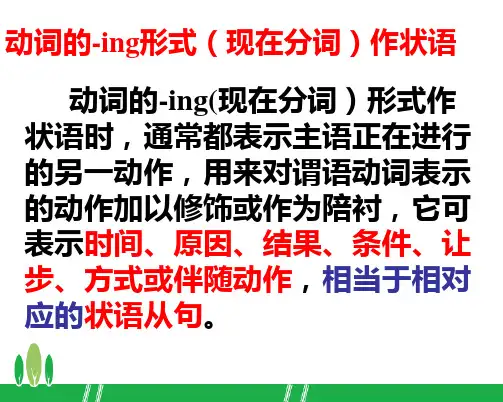
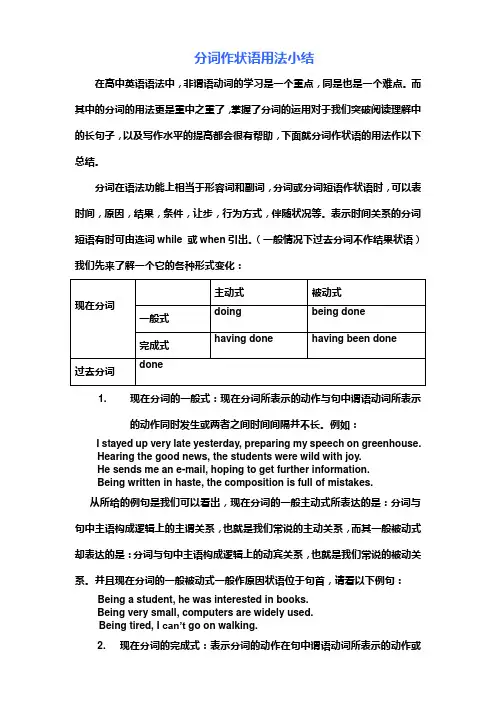
分词作状语用法小结在高中英语语法中,非谓语动词的学习是一个重点,同是也是一个难点。
而其中的分词的用法更是重中之重了,掌握了分词的运用对于我们突破阅读理解中的长句子,以及写作水平的提高都会很有帮助,下面就分词作状语的用法作以下总结。
分词在语法功能上相当于形容词和副词,分词或分词短语作状语时,可以表时间,原因,结果,条件,让步,行为方式,伴随状况等。
表示时间关系的分词短语有时可由连词while 或when引出。
(一般情况下过去分词不作结果状语)我们先来了解一个它的各种形式变化:1. 现在分词的一般式:现在分词所表示的动作与句中谓语动词所表示的动作同时发生或两者之间时间间隔并不长。
例如:I stayed up very late yesterday, preparing my speech on greenhouse.Hearing the good news, the students were wild with joy.He sends me an e-mail, hoping to get further information.Being written in haste, the composition is full of mistakes.从所给的例句是我们可以看出,现在分词的一般主动式所表达的是:分词与句中主语构成逻辑上的主谓关系,也就是我们常说的主动关系,而其一般被动式却表达的是:分词与句中主语构成逻辑上的动宾关系,也就是我们常说的被动关系。
并且现在分词的一般被动式一般作原因状语位于句首,请看以下例句:Being a student, he was interested in books.Being very small, computers are widely used.Being tired, I can’t go on walking.2. 现在分词的完成式:表示分词的动作在句中谓语动词所表示的动作或状态之前就已发生。
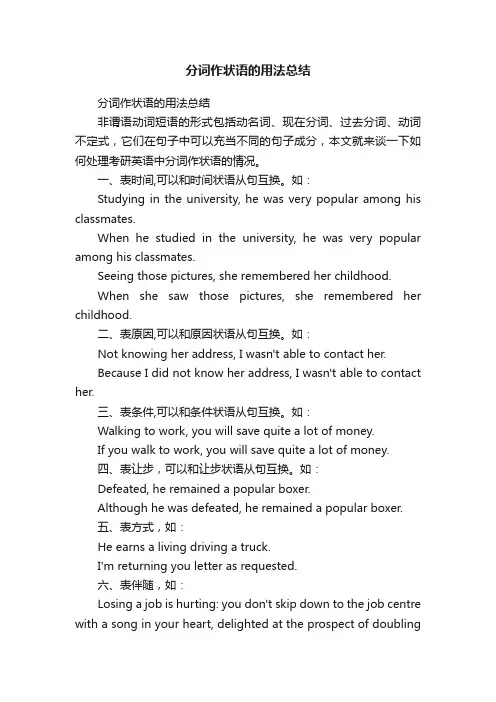
分词作状语的用法总结分词作状语的用法总结非谓语动词短语的形式包括动名词、现在分词、过去分词、动词不定式,它们在句子中可以充当不同的句子成分,本文就来谈一下如何处理考研英语中分词作状语的情况。
一、表时间,可以和时间状语从句互换。
如:Studying in the university, he was very popular among his classmates.When he studied in the university, he was very popular among his classmates.Seeing those pictures, she remembered her childhood.When she saw those pictures, she remembered her childhood.二、表原因,可以和原因状语从句互换。
如:Not knowing her address, I wasn't able to contact her.Because I did not know her address, I wasn't able to contact her.三、表条件,可以和条件状语从句互换。
如:Walking to work, you will save quite a lot of money.If you walk to work, you will save quite a lot of money.四、表让步,可以和让步状语从句互换。
如:Defeated, he remained a popular boxer.Although he was defeated, he remained a popular boxer.五、表方式,如:He earns a living driving a truck.I'm returning you letter as requested.六、表伴随,如:Losing a job is hurting: you don't skip down to the job centre with a song in your heart, delighted at the prospect of doublingyour income from the generous state.(考研阅读真题2014 Text 1) 在这个句子中,delighted分词短语作伴随状语,表示去求职中心的状态。
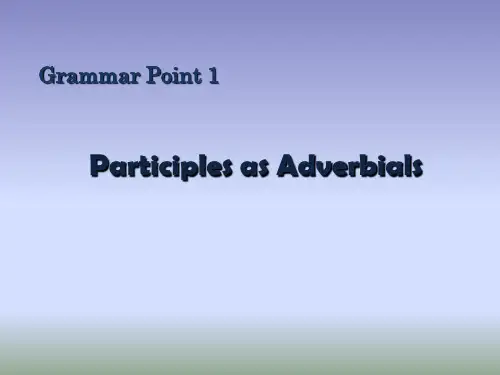
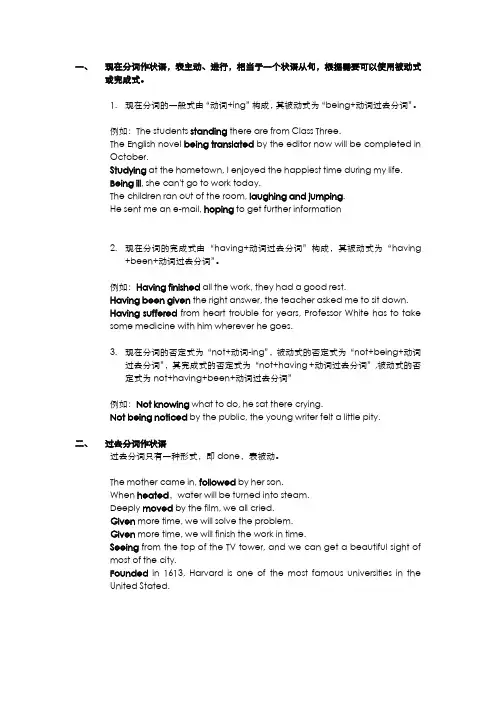
一、现在分词作状语,表主动、进行,相当于一个状语从句,根据需要可以使用被动式或完成式。
1.现在分词的一般式由“动词+ing”构成,其被动式为“being+动词过去分词”。
例如:The students standing there are from Class Three.The English novel being translated by the editor now will be completed inOctober.Studying at the hometown, I enjoyed the happiest time during my life.Being ill, she can't go to work today.The children ran out of the room, laughing and jumping.He sent me an e-mail, hoping to get further information2.现在分词的完成式由“having+动词过去分词”构成,其被动式为“having+been+动词过去分词”。
例如:Having finished all the work, they had a good rest.Having been given the right answer, the teacher asked me to sit down.Having suffered from heart trouble for years, Professor White has to takesome medicine with him wherever he goes.3.现在分词的否定式为“not+动词-ing”,被动式的否定式为“not+being+动词过去分词”,其完成式的否定式为“not+having +动词过去分词”,被动式的否定式为not+having+been+动词过去分词”例如:Not knowing what to do, he sat there crying.Not being noticed by the public, the young writer felt a little pity.二、过去分词作状语过去分词只有一种形式,即done,表被动。
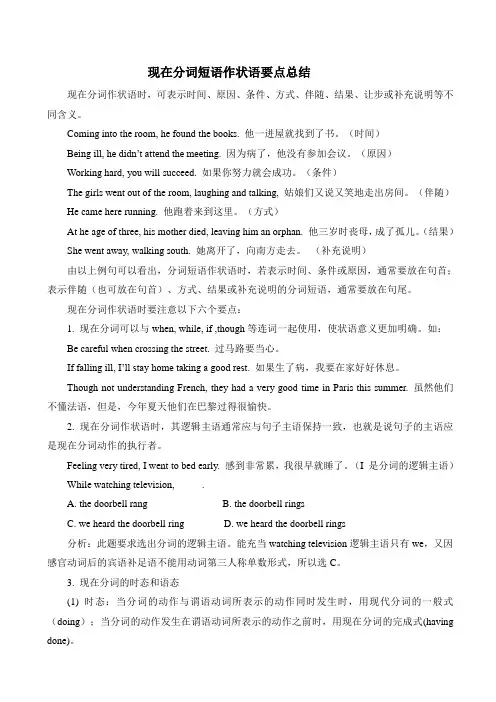
现在分词短语作状语要点总结现在分词作状语时,可表示时间、原因、条件、方式、伴随、结果、让步或补充说明等不同含义。
Coming into the room, he found the books. 他一进屋就找到了书。
(时间)Being ill, he didn’t attend the meeting. 因为病了,他没有参加会议。
(原因)Working hard, you will succeed. 如果你努力就会成功。
(条件)The girls went out of the room, laughing and talking, 姑娘们又说又笑地走出房间。
(伴随)He came here running. 他跑着来到这里。
(方式)At he age of three, his mother died, leaving him an orphan. 他三岁时丧母,成了孤儿。
(结果)She went away, walking south. 她离开了,向南方走去。
(补充说明)由以上例句可以看出,分词短语作状语时,若表示时间、条件或原因,通常要放在句首;表示伴随(也可放在句首)、方式、结果或补充说明的分词短语,通常要放在句尾。
现在分词作状语时要注意以下六个要点:1. 现在分词可以与when, while, if ,though等连词一起使用,使状语意义更加明确。
如:Be careful when crossing the street. 过马路要当心。
If falling ill, I’ll stay home taking a good rest. 如果生了病,我要在家好好休息。
Though not understanding French, they had a very good time in Paris this summer. 虽然他们不懂法语,但是,今年夏天他们在巴黎过得很愉快。
2. 现在分词作状语时,其逻辑主语通常应与句子主语保持一致,也就是说句子的主语应是现在分词动作的执行者。
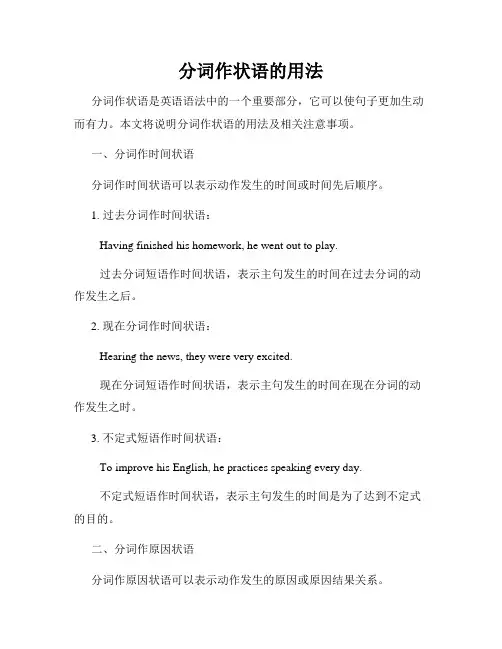
分词作状语的用法分词作状语是英语语法中的一个重要部分,它可以使句子更加生动而有力。
本文将说明分词作状语的用法及相关注意事项。
一、分词作时间状语分词作时间状语可以表示动作发生的时间或时间先后顺序。
1. 过去分词作时间状语:Having finished his homework, he went out to play.过去分词短语作时间状语,表示主句发生的时间在过去分词的动作发生之后。
2. 现在分词作时间状语:Hearing the news, they were very excited.现在分词短语作时间状语,表示主句发生的时间在现在分词的动作发生之时。
3. 不定式短语作时间状语:To improve his English, he practices speaking every day.不定式短语作时间状语,表示主句发生的时间是为了达到不定式的目的。
二、分词作原因状语分词作原因状语可以表示动作发生的原因或原因结果关系。
1. 过去分词作原因状语:Being tired, she decided to go to bed early.过去分词短语作原因状语,表示主句发生的原因是过去分词的动作。
2. 现在分词作原因状语:Seeing the dark clouds, they decided to bring umbrellas.现在分词短语作原因状语,表示主句发生的原因是现在分词的动作。
3. 不定式短语作原因状语:To save money, he stopped eating out.不定式短语作原因状语,表示主句发生的原因是不定式的目的。
三、分词作条件状语分词作条件状语可以表示动作发生的条件或条件结果关系。
1. 过去分词作条件状语:Given the chance, he would travel around the world.过去分词短语作条件状语,表示主句发生的条件是过去分词的动作。
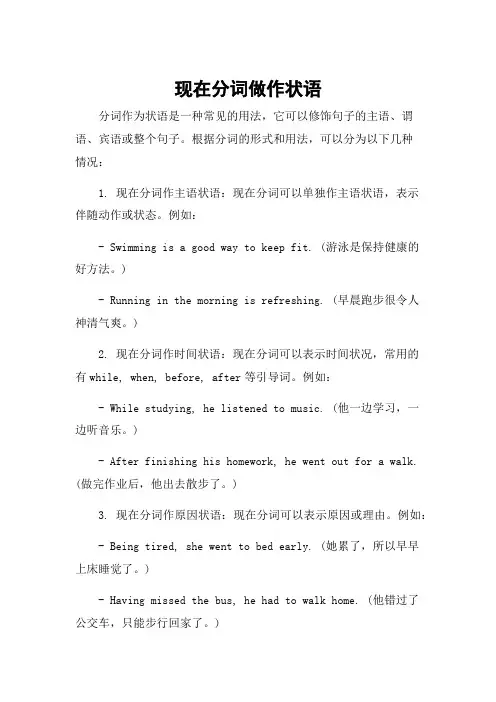
现在分词做作状语分词作为状语是一种常见的用法,它可以修饰句子的主语、谓语、宾语或整个句子。
根据分词的形式和用法,可以分为以下几种情况:1. 现在分词作主语状语:现在分词可以单独作主语状语,表示伴随动作或状态。
例如:- Swimming is a good way to keep fit. (游泳是保持健康的好方法。
)- Running in the morning is refreshing. (早晨跑步很令人神清气爽。
)2. 现在分词作时间状语:现在分词可以表示时间状况,常用的有while, when, before, after等引导词。
例如:- While studying, he listened to music. (他一边学习,一边听音乐。
)- After finishing his homework, he went out for a walk. (做完作业后,他出去散步了。
)3. 现在分词作原因状语:现在分词可以表示原因或理由。
例如:- Being tired, she went to bed early. (她累了,所以早早上床睡觉了。
)- Having missed the bus, he had to walk home. (他错过了公交车,只能步行回家了。
)4. 现在分词作结果状语:现在分词可以表示结果,常用的情况有so, therefore等引导词。
例如:- He studied hard so as to pass the exam. (他努力学习,以便通过考试。
)- The weather was bad, so they stayed at home. (天气不好,所以他们呆在家里。
)。
高考英语非谓语动词之分词作状语的用法考点解析:分词作状语的用法是所有分词用法中最重要也是最难掌握的,历年的高考英语考题也说明,分词作状语的用法是所用分词用法中最常考的。
A.B.分词作状语知识点:第一、要熟悉分词作状语的句子形式,考试中目前出现过以下三种:1.分词部分,主+谓+其他成分Seeing that she was going off to sleep, I asked if she’d like that little doll on her bed.2.主+谓+其他成分,分词部分My new house is like a huge palace, compared with his old one.3.主,分词部分,谓+其他成分Time, used correctly, is money in the bank.第二、分词形式在句中所表达的概念:时间、原因、条件、方式、让步、结果等第三、在高考题的具体解题中,一定要找准两个对象:1.找到主句的主语来确定要填分词的主被动语态形式(确定主被动的选择)2.找到主句的谓语来确定分词动作与主句谓语动词动作发生的时间先后关系(确定是否用having的形式)第四、分词作状语时,若分词表示的动作发生在主句谓语动词动作之前并结束的话,那分词就要用having done、having been done的形式,主动用having done,被动用having been done;否则,就用doing或done的形式,主动用doing 被动用done。
注意:being done的用法暂不用考虑!例一、Looking at my classmates' faces, I read the same excitement in their eyes.解析:Looking的动作并不是先发生完再发生read这个动作,因此不用having 的形式,故选择looking或looked两种形式,又由于主句主语I与look这个动作是主动关系,所以答案为looking。
现在分词在句子中作状语的用法介绍一、分词在句子中作状语,可以表示时间、条件、原因、结果、让步、伴随等。
分词(短语)作状语时,其逻辑主语应与句中主语相一致。
当现在分词表示的动作发生在谓语动词之前时, 则用现在分词的完成式;当所表示的动作与谓语的动作同时发生, 则用现在分词的一般式。
完成或被动关系用过去分词。
二、现在分词作状语时,其逻辑主语应该与句子的主语一致,但有时现在分词的主语与其所在句中的`主语并不一致,这种现在分词即所谓的垂悬现在分词。
垂悬现在分词容易使句意模糊,甚至造成歧义,因而通常被认为是不合规范或错误的用法。
1.Searching along the deck,it had taken him some time to find a doctor.他沿着甲板找了好久才找到一名医生。
searching的逻辑主语是句中的him2.Walking or sleeping,this subject was always in my mind.不论是走路或睡觉,我总是在想着这个问题。
walking or sleeping的逻辑主语是句中的my3.Traveling is interesting but tiring.旅行是有趣的,但是使人疲劳4.The pupils will get confused if they are made to learn too much.如果让学生学得太多,他们会感到糊涂的。
5.The argument is very convincing.他的论点很令人信服。
6.They were very excited at the news.听到这个消息,他们非常激动。
三、现在分词或过去分词作状语时,有时可以在分词前加while,when, once, although, until, if等连词。
1.When leaving the airport, she waved again and again to us.2.While waiting for the train, I had a long talk with my sister about her work……3.Once recovered, he threw himself into his work and made every effort to do it well.4.Although working very hard, he failed to pass the final exam.5.If translated word by word, the passage will be difficult to understand.感谢您的阅读,祝您生活愉快。
分词或分词短语作状语用法㈠分词或分词短语作状语时,可以表示① Put into use in April 2000, the hotline was meant for residents reporting water and heating supply breakdowns.Put into use in April 2000 == When it was put into use in April 2000(时间状语)② Blamed for the breakdown of the school computer network, Alice was in low spirits.Blamed for the breakdown of the school computer network == Because she was blamed for the breakdown of the school computer network(原因状语)③ Given time, he'll make a fist-class tennis player.(条件状语)Given time == If he is given time④ Left at home, John didn't feel afraid at all.Left at home == Although he was left (让步状语)① We often provide our children with toys, footballs or basketballs, thinking that all children like these things.thinking that all children like these things.== and think that all children like these things.(伴随状语)② He earns a living driving a truck.driving a truck == by driving a truck. (方式状语)高考对分词用作方式状语考得③ He fired, killing one of the passers-by.He fired and killed one of the passers-by. (结果状语)④ He died, leaving his wife with five children.He died and left his wife with five children. (结果状语)⑤ It rained and rained, vehicles bogged and bridges washed out.It rained and rained, and vehicles were bogged and bridges were washed out. (结果状语)㈡有时为了强调,分词前会加when, while, if, unless, once, though, even if, as if 等连词一起作状语When comparing different cultures, we often pay attention only to the differences.Though tired, he still continued reading.Once published,this book will be popular with the students.㈢分词(短语) 与主语的关系主语一致:分词短语的动作由主句主语发出。
分词作状语的用法可以肯定地说,分词的状语用法是所有分词用法中最重要的,也是最难掌握的。
历年的高考英语考题也说明,分词作状语的用法是所有分词用法中最常考的。
因此,本文拟对分词作状语的用法作一小结和分析,同时归纳一些行之有效的做题方法和理解技巧,以帮助同学们掌握其用法。
一、用作时间状语1. 典型例句Seeing the cat, the mouse ran off. 见到猫,老鼠就跑了。
The work finished, he went home. 工作做完后,他就回家了。
2. 理解技巧分词(短语)用作时间状语通常可转换成时间状语从句(引导时间状语的从属连词需根据句意来确定),如上面两句也可转换成:When [As soon as] the mouse saw the cat, it ran off. After the work was finished, he went home. 3. 高考实例When _______ different cultures, we often pay attention only to the differences without noticing the many similarities. (2006浙江卷) A. compared B. being compared C. comparing D. having compared 【分析】此题答案选C,分词短语when comparing different cultures 相当于时间状语从句when we compare different cultures。
二、用作原因状语1. 典型例句Being very weak, she couldn't move. 她由于身体虚弱而不能行动。
His car broken down, he had to walk. 他的车坏了,所以只好走路。
Much discouraged, she moved on to London. 她很沮丧,搬到了伦敦。
分词作状语的用法分词是中文语法中一种常见的修饰方式,可以作状语,对句子的主语、谓语或宾语进行修饰和补充,起到丰富句子意义的作用。
分词作状语可分为动词分词和形容词分词两种形式。
下面将对这两种形式的用法进行详细介绍。
一、动词分词作状语动词分词作状语通常用在句子的前面或后面,表示伴随、原因、条件、时间、方式等不同的状况。
1. 作伴随状语:表示动作的同时或与主语的动作同时进行。
例子:- 他走着走着,突然摔倒了。
- 她唱着歌,一边做家务。
2. 作原因状语:表示结果或动作的原因。
例子:- 天气太热了,我们休息了一下。
- 时间太晚了,我不敢回家。
3. 作条件状语:表示动作发生的条件。
例子:- 如有需要,我会随时提供帮助。
- 除非你同意,否则我们无法合作。
4. 作时间状语:表示动作发生的时间。
例子:- 老师站在门口,等着学生进来。
- 他一声不响地坐在那里,等待着消息。
5. 作方式状语:表示动作的方式或方式的补充。
例子:- 他冷静地看着对方,不做任何反应。
- 她快速地做完作业后,离开了教室。
二、形容词分词作状语形容词分词作状语通常用在句子的前面或后面,修饰句子的主语或宾语,描述它们的状态或特征。
1. 作状语修饰主语:表示主语的状态或特征。
例子:- 感动的故事,让听众纷纷落泪。
- 失望的结果,让他心情低落。
2. 作状语修饰宾语:表示宾语的状态或特征。
例子:- 他们把老旧的建筑物改造成了现代化的办公楼。
- 她吃惊地看着手中的礼物。
以上是分词作状语的基本用法,希望对你有所帮助。
非谓语动词用法精讲分词作状语的用法和常见形式非谓语动词用法精讲:分词作状语的用法和常见形式非谓语动词是指不作谓语,不具备时态和人称变化的动词形式,包括不定式、动名词和分词。
其中,分词作为非谓语动词的一种形式,常常被用作状语来修饰句子的主语、宾语或其他成分。
本文将重点讲解分词作为状语的用法和常见形式。
一、分词作状语的用途分词作为状语可以表示时间、原因、条件、结果、方式等不同的语义关系。
根据这些关系,分词可以用作时间状语、原因状语、条件状语、结果状语和方式状语。
1. 分词作时间状语分词作时间状语时,可以表示动作发生的时间、顺序或同时性等。
常见的分词形式包括现在分词和过去分词。
- Walking along the river, I saw a beautiful sunset.- Having finished my homework, I went out to play.- Having been a teacher for many years, he knows how to handle students.2. 分词作原因状语包括现在分词和过去分词。
- Being tired, she decided to take a nap.- Seen from the top of the mountain, the city looked magnificent.- The car crashed into a tree, causing serious injuries.3. 分词作条件状语分词作条件状语时,可以表示动作发生的条件。
常见的分词形式包括现在分词和过去分词。
- Provided with enough resources, they can finish the project on time.- Weather permitting, we will have a picnic in the park.- Given the circumstances, I had no choice but to accept the offer.4. 分词作结果状语分词作结果状语时,可以表示动作的结果或效果。
外教一对一
分词做状语用法总结
一、表时间
Turning around, she saw an ambulance driving up. 她转过身,看见一辆救护车开了过来。
Having found a hotel, we looked for somewhere to have dinner. 在找好旅馆之后,我们就去找吃饭的地方。
Asked why he came late, he said that got up late. 当他被问到为什么来晚了时,他说他起床起晚了。
二、表原因
Not knowing her address, I wasn’t able to contact her. 由于不知道她的地址,我没法和她联系。
Having been ill for a long time, he needed time to recover. 由于他病了很长时间,他需要一段恢复的时间。
Moved by their speech, I was at a loss what to say. 被他们的发言感动,我不知说什么好。
三、表条件
Taken in time, the medicine will be quite effective. 及时吃,这药会很有效的。
Sit down, Emma. You will only make yourself more tired, keeping on your feet. 坐下吧,埃玛。
你老站着,只会弄得你更累。
Seen in this light, the matter is not as serious as people generally suppose. 如从这个角度看,问题并不像人们一般料想的那样严重。
四、表让步
Although living miles away, he attended the course. 虽然住在几英里以外,他仍去上课。
Defeated, he remained a popular boxer. 虽然被击败了,他仍是一个受欢迎的拳击手。
五、表方式
He earns a living driving a truck. 他靠开卡车谋取生。
I’m returning you letter as requested. 我按要求给你退信。
六、表伴随
I offered them something to eat, thinking they might be hungry. 我给了他们一些东西吃,心想他们可能会饿。
They came in, followed by their wives. 他们走了进来,后面跟着他们的妻子。
外教一对一 Trains in this country spend too much time stopped, waiting for other trains. 火车在这个国家里停留等待其他火车的时间太长了。
七、表结果
It rained heavily, causing severe flooding in that country. 大雨滂沱,造成了那个国家洪水泛滥。
She was so angry that she threw her new doll on the floor breaking it into pieces. 她大怒,把她新买的娃娃扔在地上,摔得粉碎。